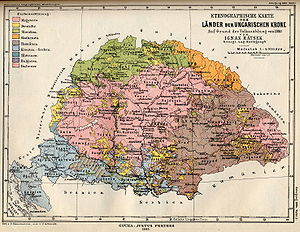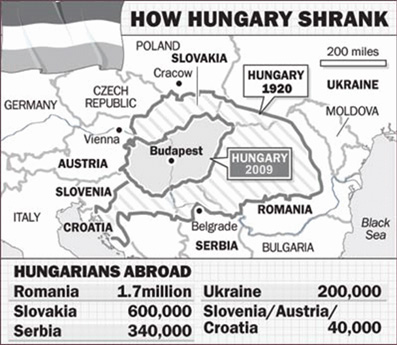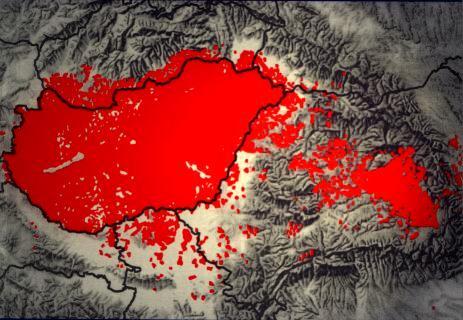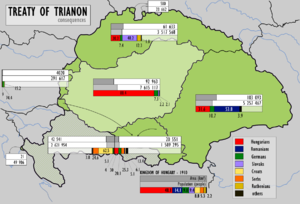Treaty of Trianon - the dismemberment of Hungary
by HUNSOR.se
The Treaty of Trianon is the peace treaty concluded at the end of World War I by the Allies of World War I, on one side, and Hungary, seen as a successor of Austria-Hungary, on the other. It established the borders of Hungary and regulated its international situation. Hungary lost over two-thirds of its territory, about two-thirds of its inhabitants under the treaty and 4.3 million ethnic Hungarians. The principal beneficiaries of territorial adjustment were Romania, Czechoslovakia, and the Kingdom of Serbs, Croats and Slovenes. The treaty was signed on 4 June 1920 at the Grand Trianon Palace in Versailles, France.
The last days of Kingdom
After the Romanian Army advanced beyond this ceasefire line, the Entente powers asked Hungary (Vix note) to acknowledge the new Romanian territory gains by a new line set along the Tisza river. Unable to reject these terms and unwilling to accept them, the leaders of the Hungarian Democratic Republic resigned and the communists seized power. The Hungarian Soviet Republic was formed and a new Hungarian Red Army was rapidly set up. This army was initially successful against the Czechoslovak Legions (see Slovak Soviet Republic) and made it possible for Hungary to reach nearly the former Galitian (Polish) border, thus separating the Czechoslovak and Romanian troops from each other.

Ethnic groups of the Hungarian Kingdom according to the 1880-census
After a Hungarian-Czechoslovak ceasefire signed on July 1, 1919, the Hungarian Red Army left Slovakia by July 4, as the Entente powers promised Hungary to invite a Hungarian delegation to the Versailles Peace Conference. In the end, this invitation was not issued. Kun turned then the Hungarian Red Army on the Romanian army and attacked at the Tisza river on 20 July 1919. After intense fighting that took some five days, the Hungarian Red Army collapsed. The Royal Romanian Army marched into Budapest on 4 August 1919. The Austro-Hungarian Monarchy fell apart.
On 1 December 1919 the Hungarian delegation was officially invited to the Versailles Peace Conference, however the new borders of Hungary were nearly finalized without the presence of the Hungarians.
Versailles, Paris 1920 - signing The Treaty of Trianon
When on place on 4th of June 1920 the Hungarian delegation has given no choice. They were obliged to sign the treaty wich meant tha cutting of 2/3 of Hungarian land to states wich actally occupied it, or actally where established from it.
The final borders of Hungary were defined by the Treaty of Trianon signed on 4 June 1920. Beside the previously mentioned territories, they did not include:
* the rest of Transylvania together with former Eastern Hungary, which became part of Romania;
* Carpathian Ruthenia, which became part of Czechoslovakia, pursuant to the Treaty of Saint-Germain in 1919;
* most of Burgenland, which became part of Austria, also pursuant to the Treaty of Saint-Germain; the district of Sopron opted to remain with Hungary after a plebiscite held in December 1921 (it was the only place where a plebiscite was permitted in the decision);
* Medjimurje and Prekmurje, which became part of the Kingdom of Serbs, Croats and Slovenes.

When the Trianon agreement was signed after the 1st World War 1919-20 Hungary lost 2/3 parts of its area to Rumania (Transylvania), Yugoslavia (Vojvodina), Croatia, Baranya and Slavonia, Slovakia (Felvidék), current Ukraine (Transcarpathia) and a small part to Austria (Burgenland).
By the Treaty of Trianon, the cities of Pécs, Mohács, Baja and Szigetvár, which were under Yugoslav administration after November 1918, were assigned to Hungary.
An arbitration committee in 1920 assigned small northern parts of the former Árva and Szepes counties of the Kingdom of Hungary with Polish majority population to Poland.
Compared with the former Kingdom of Hungary, the population of post-Trianon Hungary was reduced from 20.8 million to 7 million and its land area decreased by 72%.
After 1918, Hungary did not have access to the sea, which it had had directly through the Rijeka coastline and indirectly through the Kingdom of Croatia-Slavonia.
The peace treaty was the most hardest treaty ever signed by a single state. The Kingdom of Hungary which had over 325.000 square km was reduced by 232.000 square km, or 71,4 % and remained on 93.000 square km.
Hungary lost:
- 61,4 % of its cultivation land
- 88 % of its forest,
- 62,1 % of its railways,
- 64,5 % of its roads,
- 83,1 % of its annual iron pruduction,
- 55,7 % of its industrial facilities and companies,
- 67 % of its financial and credit companies
- 100% of its gold-, silver-, copper och salt production.
Rumania alone got 102.000 square km land from Hungary (the whole Transylvania), it means a bigger part than Hungary itself remained on 93.000 square km.
Checkoslovakia got 63.000 square km of Hungarian land and the newly estabilshed kingdom of Jugoslavia about the same. In West-Hungary the peace Treaty annexed 4.000 square km to Austria, the only case in history when to defeted states shared territories among each other!!.
At the division The Alied powers claimed the "nationality principle" that ethnic group, or simply say where ethnic groups are in the majority it determines the state of the borders. But if we look closely at the numbers, they speak their clear language, that the new borders were not impartial, and made only under the "nationality principles" of peoples.
Areas wich according to the "nationality principle" made clear Hungarian majority were cut of anyway to Hungary's disadvantage to succession States. Ethnographic border was still, in most cases not a clear and firm. But in those areas that new border just has been drawn Hungarians were all over in the clear majority.

The map shows where even today Hungarians constitute a clear majority, and proves that the border was not drawn under the "nationality principle"
In Transcarpathia, - in nowadays Ukraine, the Treaty divided Hungarian-populated villages in two, where one side of the village came to Slovakia and another to Ukraine. And it was not a lonely and isolated examples. Everything that the Serbs, Rumanians and Slovaks as the winners of war claimed and got with violence in war, practically the Western Alied powers assigned them.
But the fact is that, the 1000 years smooth functioning state of Hungary, once divided into small pieces, small contries, just couldnt work so well an neither the newly established states managed to survive for a long. Yugoslavia which was made by Trianon, vanished in the most bloodiest way, Czechoslovakia made by Trianon vanished too, and Rumania which got Transylvania just didn't succeed to create a fully functioning democracy and rule of law based on the equality for all the citizens in the face of law. This all showed us clearly that Hungary's dismemberment was not "such a big success" as it was planned, but rather a big failure.
Germany and Austria, with the peace treaty, were rather "mild" punished in comparison with Hungary, which lost 2/3 of its surface area and 4.5 one million Hungarians ended up in the newly established states.
Transylvania was now the part of the newly established Greater Romania, which profit was the highest by the end of I w.w. with receiving the biggest area from Hungary.
Treaties contained clauses that clearly described and guaranteed fundamental human rights to minorities, as the right to use their language, teaching in schools and governmental authority, the right of free expression on its own language, publicly and in newspaper and radio, but this was never respected.
They signed commitments and obligations by the Treaty of Trianon related to the fundamental human rights of minorities were never respected by the States that "grew" territorial on Hungary's expense.
Newly established states of Yugoslavia, Checkoslovakia and Greater Rumania considered themselves as national states and were only interested in their own national targets. As an example, untill the year 1913, under Hungarian rule, in Transylvania, there were 5032 public schools, of which 2482 were Hungarian, 2230 Rumanian, 282 German (sach) and 58 of other nationalities. In 1931, under Rumanian rule, had primary schools number dropped to clear Hungarians disadvantage. By 4292 public schools were now only 1248 Hungarian and Rumanian number increased to 2978, only 67 were German (sach) and 2 by other natinality.
The Hungarians also demanded that the referendum would be held on the territories which the Alied powers wanted to remove from the kingdom, but the referendum was not allowed to Hungary.
So much is to say of Western Europe's faith in democratic rules and "international law" / self-determination of the people's right over their fate, at the beginning of last century. The rules did not apply when the Hungarians fate was decided in France, far away from Transylvania, Vojvodina, Transcarpathia, Upper Hungary, Baranya, Slavonia and its people, far away from Budapest and the Hungarian Parliament.
Demographic consequences of The Treaty
According to the census of 1910, the largest ethnic group in the Kingdom of Hungary were the Hungarians, who were approximately 48% of the entire population (or 54% of the population of the territory referred to as "Hungary proper", i.e., excluding Croatia-Slavonia). The Kingdom of Hungary was not a nation-state as were many Western European nations.

Difference between the borders of the Kingdom of Hungary within Austria-Hungary and independent Hungary after the Treaty of Trianon. Based on the 1910 census.
Some demographers believe that the 1910 census overstated the percentage of the Hungarian population, pointing to the discrepancy between an improbably high growth of the number of Hungarians and the decrease of other nationalities in the kingdom in the late 19th century.[11] They also argue that there were different results in previous censuses of the Kingdom and subsequent censuses in the new states. Another problem with interpreting the census results is that the 1910 census did not record the respondents' ethnicity, but only language (whether it was "native language" or "most frequently spoken language") and the religion, thus the presented census numbers of ethnic groups in the Kingdom of Hungary are actually the numbers of speakers of various languages, which may not correspond exactly to the ethnic composition.
Although the territories of the former Kingdom of Hungary that were assigned by the treaty to neighbouring states had a majority of non-Hungarian population, they also included significant Hungarian minorities, numbering 3,318,000 in total, distributed as follows:
The number of Hungarians in the different areas based on census data of 1910.
* In Slovakia: 885,000 - 30%
* In Transylvania (Romania): 1,662,000 - 32%
* In Vojvodina (Serbia): 420,000 - 28%
* In Transcarpathia (Ukraine): 183,000 - 30%
* In Croatia: 121,000 - 3.5%
* In Slovenia: 20,800 - 1.6%
* In Burgenland (Austria): 26,200 - 9%
Population of mentioned territories based on census data of 1910:
* In Slovakia (Czechoslovakia): 1,687,977 Slovaks and 1,233,454 others (mostly Hungarians - 886,044, Germans, Ruthenians and Roma) [according to the 1921 census, however, there were 1,941,942 Slovaks and 1,058,928 others]
* In Carpathian Ruthenia (Czechoslovakia): 330,010 Ruthenians and 275,932 others (mostly Hungarians, Germans, Romanians, and Slovaks)
* In Transylvania (Romania): 2,829,454 Romanians and 2,428,013 others (mostly Hungarians and Germans)
* In Vojvodina and Croatia-Slavonia (Yugoslavia): 2,756,000 Serbo-Croatians and 1,366,000 others (mostly Hungarians and Germans)
* In Burgenland (Austria): 217,072 Germans and 69,858 others (mainly Croatian and Hungarian)
Minorities in post-Trianon Hungary
On the other hand, a considerable number of other nationalities remained within the frontiers of the new Hungary:
According to the 1920 census 10.4 % of the population spoke one of the minority languages as mother language:
* 551,211 German (6.9%)
* 141,882 Slovak (1.8%)
* 23,760 Romanian (0.3%)
* 36,858 Croatian (0.5%)
* 17,131 Serb (0.2%)
* 23,228 other Southern Slavic dialects, mainly Bunjevac and Šokac (0.3%) and some 7,000 Slovenes
The number of bilingual people was much higher, for example 1,398,729 people spoke German (17%), 399,176 people spoke Slovak (5%), 179,928 people spoke Serbo-Croatian (2,2%) and 88,828 people spoke Romanian (1,1%). Hungarian was spoken by 96% of the total population and was the mother language of 89%.
The percentage and the absolute number of all non-Hungarian nationalities decreased in the next decades, although the total population of the country increased. Bilingualism was also disappearing. The main reasons of this process were spontaneous assimilation and the Magyarization policy of the state. Minorities made up 8% of the total population in 1930 and 7% in 1941 (on the post-Trianon territory).
After WWII about 200,000 Germans were deported to Germany according to the decree of the Potsdam Conference. Under the forced exchange of population between Czechoslovakia and Hungary, approximately 73,000 Slovaks left Hungary. After these population movements Hungary became an ethnically almost homogeneous country except the rapidly growing number of Roma people in the second half of the 20th century.
Political consequences
Officially, the treaty was intended to be a confirmation of the concept of the right for self-determination of nations and of the concept of nation-states replacing old multinational empires.
From the point of view of most non-Hungarians that lived in the former Kingdom of Hungary, after centuries of foreign rule, most of the peoples of former Austria-Hungary (often called a 'dungeon of nations' by them) would finally achieve a right for self-determination and independence, and be united with other members of their nation (except, the Hungarians themselves). Over the previous fifty years, the Balkan nations had won their independence from the declining Ottoman Empire; now the victorious Allies saw their task as completing that same process further north following the dissolution of the Habsburg Empire.
On the other hand, Hungarians (and some non-Hungarian historians as well) claim that the real motive of the treaty was simply an attempt to dismantle a major power in Central Europe. The Western powers' main priority was to prevent a resurgence of Germany and they therefore decided that her allies in the region, Austria and Hungary, should be "contained" by a ring of states friendly to the Allies, each of which would be bigger than either Austria or Hungary. Compared with the Habsburg Kingdom of Hungary, post-Trianon Hungary had 60% less population and its role in the region significantly weakened.
Many cities and regions that were ethnically diverse in the 19th century became for the most part monoglot (unilingual), or dominated by a single language and culture.
The Treaty and its consequences are debated in Central European politics to this day. The main controversy about the Treaty of Trianon concerns the borders of Hungary. While the majority of the areas that had been part of the Kingdom of Hungary but were not part of the independent country after the Treaty were inhabited by non-Hungarian nationalities, there were also many areas inhabited mainly by Hungarians which were not located within the borders of Hungary after the Treaty, and there have periodically been concerns about the treatment of these ethnic Hungarian communities in the neighboring states. Areas with significant Hungarian populations include the Székely Land[16] in Eastern Transylvania and some areas along the new Romanian-Hungarian border, southern parts of Slovakia (see: Komárno, and mostly the south of Slovakia, like Csallóköz), southern parts of Carpatho-Ukraine, northern parts of Vojvodina (see: Ethnic groups of Vojvodina), etc.
The Western powers were aware of the problem posed by the presence of so many Hungarians (and Germans) living outside the core areas of the "new" nation-states of Hungary and Austria, although they assumed that the problem would solve itself over time as they expected that those ethnic Hungarians who were unhappy would gradually sell up and go to live in Hungary, which did not turn out to be the case. The Romanian delegation to Versailles feared in 1919 that the Allies were beginning to favour the partition of Transylvania along ethnic lines in order to reduce the potential exodus and Prime Minister Ion I. C. Bra(tianu even summoned British-born Queen Marie to France to strengthen their case. The Romanians argued that they had suffered a higher casualty rate in the war than either Britain or France and that the Western powers had a moral debt to repay. Ethnically diverse Transylvania should therefore be assigned to Romania. In the end the Romanian view prevailed and the option of partition was rejected. Transylvania was treated as a single entity which, because it had a Romanian majority overall, was assigned in entirety to Romania. Furthermore the Allies rejected the idea of plebiscites in any of the disputed areas with the exception of the city of Sopron, which voted to remain in Hungary (the Allies were indifferent as to the exact line of the new border between Austria and Hungary).
The victorious Allies arrived in France with a black-and-white view of the situation in central Europe which made the outcome inevitable. At the heart of the dispute lay fundamentally different views of the nature of the Hungarian presence in the disputed territories. For the Hungarians the whole of the Carpathian Basin was seen as "home" (including its parts mainly inhabited by non-Hungarians who saw this area as their own "home" as well). The western powers and the American press in particular (as well as most non-Hungarians that lived in the Carpathian Basin) saw the Hungarians as colonial-style rulers who had oppressed the Slavs and Romanians since 1867. There was therefore no difference between the Turks giving up Serbia in the late nineteenth century and Hungarians giving up Transylvania or Ruthenia. For President Wilson (and for most non-Hungarians from the Carpathian Basin) it was a process of decolonisation rather than a punitive dismemberment (as Hungarians saw it).[17] The Hungarians saw it so, because, the borders where not ethnically correct, and territories with Hungarian majority were put outside the "mock borders". The British Prime Minister David Lloyd-George was in favour of Irish independence from Britain and saw the claims of the "subject peoples" of the former Habsburg Empire in the same light. The French naturally sided with their "Latin brothers", the Romanians, although Clemenceau personally detested Bratianu.
Opposite to the opinion of most non-Hungarians from the Carpathian Basin, the Hungarians did not regard the outer parts of the former Kingdom of Hungary as colonial territories. For Hungarian public opinion the realisation that the Americans, British and French were all convinced that at least half of the Carpathian Basin rightfully belonged to the Slavs and Romanians was profoundly shocking. Hungarians also considered the accusations as hypocrite, which also contributed to a sense of injustice. Incredulity was followed by a lingering bitterness and, in Hungary, the loss is to this day known as the Trianon trauma. The perceived humiliation of the treaty became a dominant theme in inter-war Hungarian politics, analogous with the German reaction to the Treaty of Versailles. All official flags in Hungary were lowered until 1938 when they were raised by one third after southern Slovakia was "recovered" following the Munich Conference. For Hungarian pupils in the 1930s each school-day began with a prayer calling for the reversal of the treaty.
Other consequences
Economically, 61% of arable land, 88% of timber, 62% of railroads, 64% of hard surface roads, 83% of pig iron output, 55% of industrial plants and 67% of credit and banking institutions of the former Kingdom of Hungary lay within the territory of Hungary's neighbours. Romania, Yugoslavia and Czechoslovakia had to assume part of the financial obligations of the former Kingdom of Hungary on account of the parts of its territory under their sovereignty.
Military considerations diverted the Treaty from the Wilson principles, making economic cooperation within the Carpathian Basin more difficult. The borders bisected transport links - in the Kingdom of Hungary the road and railway network had a radial structure, with Budapest in the centre. Many roads and railways running along the new borders and interlinking radial transport lines lay within the territory of Hungary's neighbours.
The military conditions were similar to those imposed on Germany by the Treaty of Versailles; the Hungarian army was to be restricted to 35,000 men and there was to be no conscription. Further provisions stated that in Hungary, no railway would be built with more than one track (even going so far as to remove one of the two tracks on one of the lines).
Hungary also renounced all privileges in territories outside Europe that belonged to the former Austro-Hungarian monarchy.
Articles 54–60 of the Treaty required Hungary to recognize various rights of national minorities within its borders but the same rights even if granted were never respected in newly established states for Hungarians. The Trianon Treaty was peace, the end peace.
Edited, written by HUNSOR
Sources:
"The History of Hungary"
by Dominicus Kosáry
professor in History on Eötvös-Collegium in Budapest
with preface by professor Sven Tunberg,
published and printed in Stockholm 1944
in cooperation with Johannes Lotz and Dominicus Kosáry
Internet adresser:
- Treaty of Trianon, 1920
- "East-Central European Syndrome"- by S.J. Magyarody
- A Case Study on Trianon
- Hungary and Her Successors - The Treaty of Trianon and its Consequences 1919-1937
- Borders of Trianon - by Palotas, Z.
- The Unmaking of Peace
- Kartor över Ungern

 
|
Read more on
Hungarian History...
Here can you finde
even more
information facts on Hungary.
|

